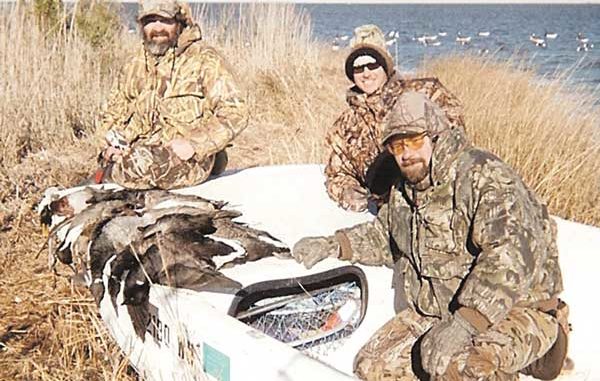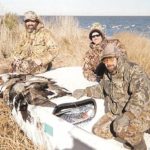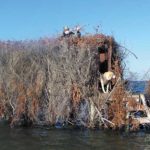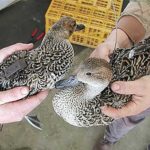
Belly up to the sand bars of Pamlico Sound for fast wing-shooting at redheads, brant and pintails this winter.
When the weather turns ugly, head to the Outer Banks for North Carolina’s premier duck hunting.
From a distance, a man wading through knee-deep water in Pamlico Sound looks suspicious, perhaps even heavenly, until one looks and sees a small low-profile blind on stilts in the background.
With no nearby land, hunters begin to understand the principals of a barrier reef — even though these reefs are made of sand rather than coral. Created by currents and tides just inland from the barrier islands that make up the Outer Banks, these sand reefs have more appeal than just allowing a man to take a stroll at the edges of Pamlico Sound.
“These reefs are nothing more than long sand bars,” said Ken Dempsey, who owns and operates Dempsey’s Guide Service of Cape Hatteras. “But they’re dynamite duck attractors, partly because they give the ducks a visual reference when they fly along the sound. The other reason is the bars are covered in eel grass, spartina, and shoal grass. Other than hunters, ducks can raft and loaf along these reefs and don’t have any natural predators out there.”
During the past, Dempsey and other outfitters took clients to hunt from curtain box blinds — and it was miserable. Although they offered hunters a fisheye view of the sky, the curtain boxes sat low in the water and were cold, uncomfortable and wet.
“It was for clients to put a lot of effort into hunting when they were getting a face full of winter water every few minutes,” Dempsey said. “It was for that reason that most of the outfitters converted over to stake blinds.”
A stake blind is a permanent structure built of wood or similar materials and anchored into the sand. However, anyone constructing or hunting from a stake blind in Dare or Currituck counties must have a permit and as the number of permits is limited, visiting hunters are almost totally reliant on outfitters or guides who own permitted blinds.
“Stake blinds will work just as well as the old curtain boxes — if they’re placed in the right areas where hunters can take full advantage of prevailing winds as ducks fly along either the front of back edge of the reefs,” Dempsey said,
Pamlico Sound draws a number of highly-prized waterfowl species during the winter, none so desired as northern pintails.
“Most people who come here to hunt want to take a male pintail or a ‘bull sprig’ —whichever name you prefer — and they want to mount it,” Dempsey said. “According to the biologists, we get a good number of pintails in the Sound each year that come down from Canada. The tough part is figuring out what part of the Sound they’ll be using when they get here.”
Dempsey said duck hunting at Pamlico Sound (the east side in particular) is similar to a lottery because of the weather. Once upon a time, cold weather forced ducks south, and everyone had good shooting. But with recent warmer-than-average winters, Dempsey has noticed other factors play a big part in where and when pintails — as well as geese and redheads — drop in for a visit.
“We’re seeing birds migrate to different areas of the Sound because of prevailing winds,” he said. “A predominant northwest wind over the course of the winter is good for Hatteras, and we get a lot of ducks when the wind blows out of the northwest. A northeast wind is still good for us, but if we have a year with a lot of easterly winds, the ducks will push further inland and the guys over around Mattamaskeet and areas inland get better hunting. Likewise, a west wind will push ducks down to Ocrakoke, and those guys win the lottery.”
Dempsey is fortunate to have permits to maintain blinds across a 12-mile stretch that runs from Hatteras Inlet to about halfway down Okracoke Island. He maintains 18 blinds and said one of the keys to hunting his blinds (or anyone else) is to vary the hunting pressure so the ducks don’t stay away from a particular set of blinds altogether.
“Continuous pounding day after day will teach wary birds such as pintails and redheads to avoid that reef altogether,” he said.
Another factor Dempsey credits with his clients’ success is setting and moving the decoys each day. He contends ducks wise up to a set of decoys that remain in the same spot for days on end. He also said shifting wind patterns will cost an outfitter decoys by blowing the dekes out to sea when the direction changes from inland to offshore overnight.
“We live or die by the weatherman out here,” he said. “My guides and I will set up a group of decoys to put our blinds downwind from the decoy spread and if the forecast is wrong, we can have some hard days requiring us to get up way before we get hunters out to reposition the decoys.
“Once our hunts are over around 1:30 or 2 p.m., we’ll be back out there again, getting set up for the next day.”
Fortunately for Pamlico Sound hunters, the area gets a lot of bad weather — which means strong winds throughout the winter.
The ideal situation if ducks are in the area is to have 20- to 25-mph winds blowing from the north on top of a falling tide at daylight. The guide doesn’t like too much wind as speeds higher than 35 mph won’t allow pintails to decoy as well.
While Dempsey does a fair amount of calling during calm days, he said calling isn’t an absolute necessity and is practically useless in a high wind. Most of the time the birds won’t hear the call until they’ve swung into and past the blind, although there are days when brant geese respond to a good call.
“This isn’t drop-in-your-face decoying, like some hunters may expect when hunting a river or at a swamp,” Dempsey said. “It’s an open-water hunt and can be challenging for an average shooter.
“You need to be good at passing shots and expect to take some longer-than-average shots as well. That’s why why premium ammo is a must out here.”
Dempsey’s ideal load for hunting Pamlico Sound pintails is a 3-inch Hevi-Shot cartridge of No. 4 shot with 1 ½ ounces of lead. He recommends a modified choke and has found Hevi Shot loads pattern well on less choke than a comparable steel load.
He sees a lot of Remington and Bennelli shotguns in his blinds and said blowing salt spray and bumpy boat rides in heavy winds aren’t kind to typical show-quality guns (over-and-unders and even some auto-loaders).
“Bring your meat gun,” he said, “the one you rely on to shoot well in any condition and that can handle a stout load. You didn’t come all this way to miss.”







Be the first to comment